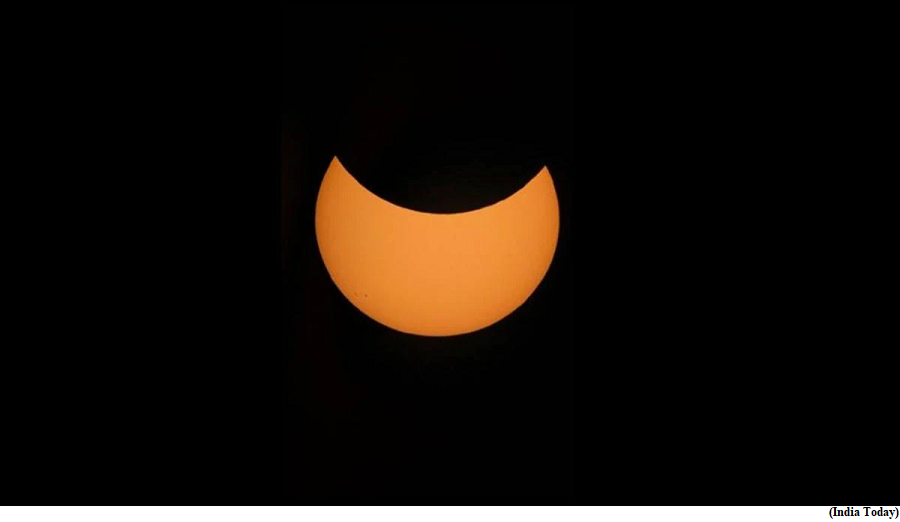Moon to block Sun in rare event: What is hybrid solar eclipse? (GS Paper 1, Geography)

Why in news?
- A hybrid solar eclipse will take place on April 20 as the moon blocks the sunlight coming toward Earth.
Details:
- A hybrid solar eclipse involves all three areas of the Moon's shadow - the umbra, penumbra, and the antumbra, and then combines all three types of solar eclipses.
- The hybrid eclipse occurs when Earth travels through the area where the Moon's umbra (darkest part of the moon's shadow) meets its antumbra, a half-shadow that begins where the umbra ends.
What is Solar Eclipse?
- A solar eclipse is an astronomical phenomenon that occurs when the Moon passes between the Sun and Earth, blocking all or part of the Sun's light from reaching Earth. The Moon's shadow is cast on the Earth's surface, creating temporary darkness in some parts of the world that fall in its vicinity.
- There are three types of solar eclipses: total, partial, and annular.
- In a total solar eclipse, the Moon completely covers the Sun, and only the Sun's outer atmosphere (called the corona) is visible like a thin peel.
- In a partial solar eclipse, the Moon only partially covers the Sun, and a portion of the Sun's light is still visible.
- In an annular solar eclipse, the Moon appears smaller than the Sun, and a ring of the Sun's light is visible around the Moon.
What is hybrid solar eclipse?
- The solar eclipse will be a hybrid solar eclipse, a rare phenomenon that looks like an annular solar eclipse or a total solar eclipse depending on the location from where it is being observed.
- According to time and date, during the hybrid solar eclipse, Earth's curvature brings some sections of the eclipse path into the Moon's umbra, the darkest part of its shadow that creates total solar eclipses, while other areas remain outside the umbra's reach, causing an annular eclipse.
- Solar eclipses are in itself rare as they only occur about once every 18 months. They can only be seen from certain parts of the world, and those areas where the eclipse is visible will experience varying degrees of darkness.
- A solar eclipse also does not come alone and is accompanied by a lunar eclipse that happens a few weeks before or after the phenomenon.
Indian-American C.R. Rao wins Nobel Prize equivalent in statistics
(Miscellaneous)
Why in news?
- Recently, the Indian-American statistician Calyampudi Radhakrishna Rao has been awarded the 2023 International Prize in Statistics, the equivalent of the Nobel Prize for statistics.

Why he was chosen for the award?
- He has influenced, in the words of the American Statistical Association, “not just statistics” but also “economics, genetics, anthropology, geology, national planning, demography, biometry and medicine”.
- The citation for his new award calls him “a professor whose work more than 75 years ago continues to exert a profound influence on science”.
Achievements:
- His groundbreaking paper, “Information and accuracy attainable in the estimation of statistical parameters”, was published in 1945.
- He did his Ph.D. in 1946-1948 at King’s College, Cambridge University, under the supervision of Ronald Fisher, regarded as the father of modern statistics.
- The 1945 paper boosted the development of modern statistics and its application in research.
Rao score test:
- One of Professor Rao’s papers in 1948 offered a novel generic approach to testing hypotheses, now widely known as the “Rao score test”.
- This and two other tests, developed by Jerzy Neyman, E.S. Pearson and Abraham Wald, are sometimes called “the holy trinity” of this branch of statistics.
- He also contributed to orthogonal arrays, a concept in combinatorics used to design experiments whose results are qualitatively good, as early as 1949.
- He was awarded the title of Padma Bhushan by the Indian Government (1968) and Padma Vibhushan in 2001.
About International Prize in Statistics:
- It is awarded once every two years to an individual or team “for major achievements using statistics to advance science, technology and human welfare”.
- The prize recognises a major achievement by an individual or team in the statistics field, particularly an achievement of powerful and original ideas that have led to practical applications and breakthroughs in other disciplines.
- The prize is modelled after the Nobel prizes, Abel Prize, Fields Medal and Turing Award.
- The first International Prize in Statistics was awarded in 2017 to David R Cox for the development of the Cox proportional hazards model, which allows researchers to investigate patient survival rates in complex studies.
- Bradley Efron received the award in 2019 for a statistical method known as the bootstrap, a clever computational method for assessing uncertainty in applied statistics.
- Nan Laird received the award in 2021 for the development of powerful methods that have made possible the analysis of complex longitudinal studies
Way Forward:
- He will receive the prize, which comes with a USD 80,000 award, in July 2023 at the biennial International Statistical Institute World Statistics Congress in Ottawa, Ontario, Canada.



